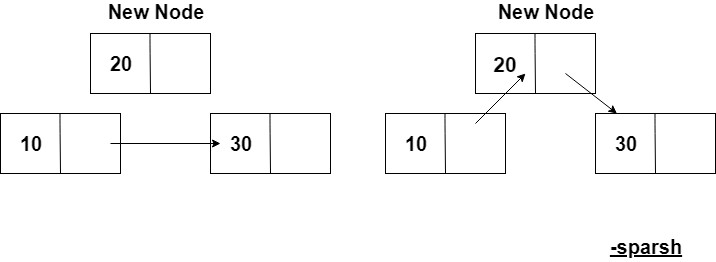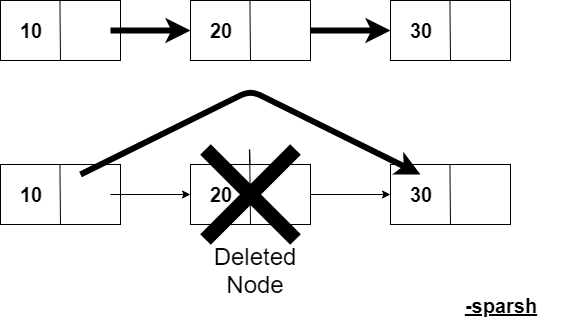链接列表插入方法 (Linked List Insert Methods)

Linked List Insert
链表插入
Linked List insert methods allow us to insert a Node at a specific place. There are three insert methods based on the position where the new node is inserted.
链接列表插入方法使我们可以在特定位置插入Node。 根据插入新节点的位置,有三种插入方法。
- addLast addLast
- addFirst addFirst
- addAt addAt
1. addLast (1. addLast)
As the name suggests, the new node is appended at the last position of the Linked list. The Linked List size is increased by 1. The “tail” points to the newly added Node. Since we have tail Node, the time complexity is O(1) else it would have been O(n).
顾名思义,新节点将附加在“链接”列表的最后一个位置。 链接列表的大小增加1。“ tail”指向新添加的Node。 由于我们有尾节点,因此时间复杂度为O(1),否则为O(n)。
2. addFirst (2. addFirst)
The new node is added at the first position of the Linked list. The Linked List size is increased by 1. The “head” points at the newly added Node. The time complexity is O(1) as there is no traversal of List is involved.
新节点将添加到“链接”列表的第一个位置。 链接列表的大小增加1。“ head”指向新添加的Node。 由于不涉及List的遍历,因此时间复杂度为O(1)。
3. addAt (3. addAt)
This method has two arguments – the Node to insert and an integer index (say ‘k’). The node is added at the kth position of the Linked list. The linked list size is increased by 1.
此方法有两个参数–要插入的Node和一个整数索引(例如'k')。 节点被添加到“链接”列表的第k个位置。 链接列表的大小增加1。
In case the element to be added is “First” or “Last” then it calls “addFirst” or “addLast” respectively.
如果要添加的元素是“ First”或“ Last”,则分别调用“ addFirst”或“ addLast”。
In this operation, we also use another function “getNodeAt” which is a private member of Our Linked List class. This function takes an integer index as an argument and if the index is valid (i.e. if index>=0 and index <size of the Linked list) it returns the Node at that index.
在此操作中,我们还使用另一个函数“ getNodeAt”,它是我们的链接列表类的私有成员。 该函数将整数索引作为参数,如果索引有效(即,如果索引> = 0,并且索引<链表的大小),则它将返回该索引处的节点。
Thus in this function traversal of the linked list is required. The time complexity of addAt() function is O(n).
因此,在此功能中,需要遍历链接列表。 addAt()函数的时间复杂度为O(n)。
链接列表删除方法 (Linked List Delete Methods)

Linked List Delete
链接列表删除
Linked List supports three methods to delete nodes.
链表支持三种删除节点的方法。
- removeLast removeLast
- removeFirst removeFirst
- removeAt removeAt
1.删除最后 (1. removeLast)
This method removes the last element of the Linked list (Provided the list is not an empty list, in which it throws an exception). It moves the “tail” to point towards the 2nd last element (if any ) and decreases the size by ‘1’. Also, it returns the removed data. Since we have tail Node, therefore, the time complexity is O(1) else it would have been O(n).
此方法删除链接列表的最后一个元素(提供的列表不是一个空列表,它会引发异常)。 它将“尾巴”移至最后一个第二个元素(如果有的话),并将大小减小“ 1”。 同样,它返回删除的数据。 由于我们有尾节点,因此,时间复杂度为O(1),否则为O(n)。
2. removeFirst (2. removeFirst)
It removes the first element of the Linked list (Provided the list is not an empty list, in which it throws an exception). This method moves the “head” to point towards the 2nd element (if any ) and decreases the size by ‘1’. Also, it returns the removed data. The time complexity is of O(1) as there is no traversal of List is involved.
它删除“链表”列表的第一个元素(如果列表不是空列表,则在其中引发异常)。 此方法将“ head”移至第二个元素(如果有的话),并将大小减小“ 1”。 同样,它返回删除的数据。 由于不涉及List的遍历,所以时间复杂度为O(1)。
3. removeAt (3. removeAt)
It takes an Integer index (let’s say k) as an argument and if the index is valid it removes the ‘kth’ element of the Linked list and decreases the size by ‘1’.
它使用一个整数索引(比如说k)作为参数,如果该索引有效,它将删除“链表”的“ kth”元素并将其大小减小“ 1”。
Also, it returns the removed data. In case the element to be removed is “First” or “Last” then it calls “removeFirst” or “removeLast” respectively.
同样,它返回删除的数据。 如果要删除的元素是“ First”或“ Last”,则分别调用“ removeFirst”或“ removeLast”。
In this operation, we also use another function “getNodeAt” which is a private member of the Linked List class. This function takes an integer index as an argument and if the index is valid (i.e. if index>=0 and index <size of the Linked list) it returns the Node at that index.
在此操作中,我们还使用另一个函数“ getNodeAt”,它是链接列表类的私有成员。 该函数将整数索引作为参数,如果索引有效(即,如果索引> = 0,并且索引<链表的大小),则它将返回该索引处的节点。
Thus in this function traversal of the list is required, therefore, it is of O(n) which makes the time complexity of operation “removeAt” to be O(n).
因此,在该函数中,需要遍历列表,因此,是O(n),这会使操作“ removeAt”的时间复杂度变为O(n)。
链表插入删除方法的Java实现 (Linked List Insert Delete Methods Implementation in Java)
package com.journaldev.ds;
public class LinkedList1 {
private class Node {
int data;
Node next;
}
private Node head;
private Node tail;
private int size;
public int size() {
return this.size;
}
public int getFirst() throws Exception {
if (this.size == 0) {
throw new Exception("LL is Empty.");
}
return this.head.data;
}
public int getLast() throws Exception {
if (this.size == 0) {
throw new Exception("LL is Empty.");
}
return this.tail.data;
}
public int getAt(int idx) throws Exception {
if (this.size == 0) {
throw new Exception("LL is Empty.");
}
if (idx < 0 || idx >= this.size) {
throw new Exception("Invalid Index.");
}
Node temp = this.head;
for (int i = 1; i <= idx; i++) {
temp = temp.next;
}
return temp.data;
}
private Node getNodeAt(int idx) throws Exception {
if (this.size == 0) {
throw new Exception("LL is Empty.");
}
if (idx < 0 || idx >= this.size) {
throw new Exception("Invalid Index.");
}
Node temp = this.head;
for (int i = 1; i <= idx; i++) {
temp = temp.next;
}
return temp;
}
public void addLast(int item) {
// create
Node nn = new Node();
nn.data = item;
nn.next = null;
// attach
if (this.size > 0)
this.tail.next = nn;
// dm update
if (this.size == 0) {
this.head = nn;
this.tail = nn;
this.size += 1;
} else {
this.tail = nn;
this.size += 1;
}
}
public void addFirst(int item) {
// create
Node nn = new Node();
nn.data = item;
nn.next = null;
// attach
nn.next = this.head;
// dm update
if (this.size == 0) {
this.head = nn;
this.tail = nn;
this.size++;
} else {
this.head = nn;
this.size++;
}
}
public void addAt(int item, int idx) throws Exception {
if (idx < 0 || idx > this.size) {
throw new Exception("Invalid Index.");
}
if (idx == 0) {
addFirst(item);
} else if (idx == this.size) {
addLast(item);
} else {
// create
Node nn = new Node();
nn.data = item;
nn.next = null;
// attach
Node nm1 = getNodeAt(idx - 1);
Node np1 = nm1.next;
nm1.next = nn;
nn.next = np1;
// dm
this.size++;
}
}
public int removeFirst() throws Exception {
if (this.size == 0) {
throw new Exception("LL is empty.");
}
Node temp = this.head;
if (this.size == 1) {
this.head = null;
this.tail = null;
this.size = 0;
} else {
this.head = this.head.next;
this.size--;
}
return temp.data;
}
public int removeLast() throws Exception {
if (this.size == 0) {
throw new Exception("LL is empty.");
}
Node temp = this.tail;
if (this.size == 1) {
this.head = null;
this.tail = null;
this.size = 0;
} else {
Node sm2 = getNodeAt(this.size - 2);
sm2.next = null;
this.tail = sm2;
this.size--;
}
return temp.data;
}
public int removeAt(int idx) throws Exception {
if (this.size == 0) {
throw new Exception("LL is empty.");
}
if (idx < 0 || idx >= this.size) {
throw new Exception("Invalid Index.");
}
if (idx == 0) {
return removeFirst();
} else if (idx == this.size - 1) {
return removeLast();
} else {
Node nm1 = getNodeAt(idx - 1);
Node n = nm1.next;
Node np1 = n.next;
nm1.next = np1;
this.size--;
return n.data;
}
}
public void display() {
System.out.println("----------------------");
Node temp = this.head;
while (temp != null) {
System.out.print(temp.data + " ");
temp = temp.next;
}
System.out.println(".");
System.out.println("----------------------");
}
public static void main(String[] args) throws Exception {
LinkedList1 list = new LinkedList1();
list.addLast(10);
list.addLast(20);
list.addLast(30);
list.addLast(40);
// this will display the list
list.display();
// 10 should be removed and printed
System.out.println(list.removeFirst());
list.display();
// 40 should be removed and printed
System.out.println(list.removeLast());
list.display();
// list without 10 and 40 should be printed
list.display();
// 100 should be added at first
list.addFirst(100);
list.display();
// 30 should be removed
list.removeAt(2);
list.display();
// 300 should be added at 2nd index
list.addAt(300, 2);
list.display();
}
}Output
输出量

Linked List Insert Delete Implementation in Java
Java中的链表插入删除实现
翻译自: https://www.journaldev.com/30501/linked-list-insert-delete-methods





















 663
663

 被折叠的 条评论
为什么被折叠?
被折叠的 条评论
为什么被折叠?








